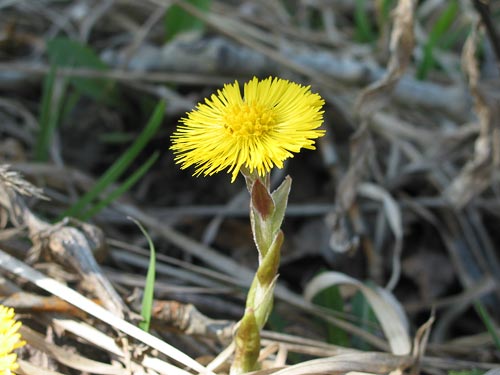Weeds
Tussilago farfara L. - Tussilago farfara
Taxonomy.
Family Asteraceae Dumort. (Compositae), Genus Tussilago L. Now in territory of the former USSR of subspecies is not present.Biology type.
The root-offspring perennial.Morphology anf biology.
Stem up to 5-25 cm in height, straight-stalked, woolly-fluffy, more or is less densely covered with oblong sheet scales. Inflorescence - single, 2-2,5 sm in diameter at fructification hanging. Leaves radical, appearing after flowering, heart-shaped, gear, from the bottom side - white - felt, from the top side - naked. Seeds golden-yellow, oblong, 3-4 mm in length, 0.4-0.5 mm in width and 0.25 mm thickness, with longitudinal edges, slightly tetrahedral, flattened, to the basis little bit narrowed, above truncated. Flying cop lagging behind, from thin and fragile silky hair. The plant blossoms before occurrence of leaves, very much early spring, now after thawing a snow, since March up to the middle of May. It is made multiple copies by seeds and rhizomes. One plant can form 5000-17000 seeds. Seeds are carried by a wind and, getting on damp ground, now sprout. Rhizomes settle down several circles at different levels and are far distributed in the parties(sides) (up to 2 м) and deep into (sometimes from above 1 м), grasping the big area. Rather thick rhizomes Tussilago differ juiciness and very big fragility. Thereof they easily break at processing ground and are taken away on a field by instruments. Each small fragment having 1 - 2 buds, is capable to sprout quickly. Tussilago forms continuous thrickets and gives such weight of leaves, that completely covers ground and suppresses cultural plants.Distribution.
Europe, Northern Africa, Asia Minor. In territory of the former USSR: the European part; Caucasus; a southern part Western and Eastern Siberia; occasionally in Central Asia, sometimes as adventik plant on the Far East.Ecology.
The plant of crude habitats growing almost on all territory of the USSR. It is widely distributed in a wood zone. In steppe and deserted zones, and also in mountains, it meets seldom, occasionally growing on damp lawns, on water canals and coast of the rivers, on young alluvial deposits. The inhabitant poor and not enough rich ground. Litters crops in a wood zone where frequently meets in crops of long-term grasses and winter crops, it is rare - in summer and vegetable cultures.Economic value.
Distributed weed, and also melliferous and a herb.Measures of struggle. Struggle against this weed should be spent in a stage of the shoots quickly destroyed by superficial processings of ground, and also application of herbicides. As the inhabitant of crude places Tussilago in some cases disappears at the device of a drainage of fields. Well taken roots and developed plants Tussilago are the best way for destroying repeated plowings during dry time for drying and exhaustions of a weed. Then on such fields it is necessary to sow winter Secale or a summer mix Vicia and Avena.
Related references.
Kott S.A. Weed of a plant and measures of struggle against them. M.: Selhosgis, 1955. educ. 2. 384 p.Maltsev A.I. Atlas of the major species of weed plants of the USSR. M. - L., 1937. Т. 1. 168 p.
Maltsev A.I. Weed of a plant of the USSR / under educ. acad. B.A.Keller, etc. M. - L., 1935. Т. 4. 414 p.
Nikitin V.V. Weed of a plant of flora of the USSR. L.: the Science, 1983. 454 p.
Ramenskij L.G., Tsatsenkin I.A., Chizhikov O.N., Antipin N.A. Ecological an estimation fodder places on a vegetative cover. М., 1956. 472 p.
Uljanova T.N. Weed of a plant in flora of Russia and other countries SNG. SPb, 1998. 233 p.
Tcherepanov S.K. Vascular of a plant of Russia and the adjacent states (within the limits of the former USSR). SPb, 1995. 991 p.


